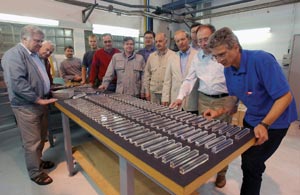
The first 500 crystals for the ALICE experiment’s photon spectrometer (PHOS) arrived at CERN in May after a journey via Moscow from the town of Apatity in the Russian arctic region. The experiment is optimized to study heavy-ion collisions and is scheduled to start data-taking in 2007. These crystals are the first of 17,000 that will make up the experiment’s PHOS – a sort of thermometer for the deconfined plasma of quarks and gluons that ALICE physicists hope to study. Denser than iron, the crystals’ lead tungstate scintillates when struck by photons, allowing the photon spectrum to be measured.
ALICE is not the only Large Hadron Collider experiment that will employ lead tungstate crystals; CMS will use some 80,000 of them in its electromagnetic calorimetry. Such a large order tied up the existing production capacity for such crystals and meant that ALICE had to look elsewhere. The solution was to recommission facilities at a former military factory in Apatity in the Murmansk region of northern Russia. Crystals are grown in ovens at more than 1000°C in a process that takes 60-70 h, during which the temperature must be constant and all vibration avoided. With 25 furnaces in operation at Apatity, around 100 people are employed in producing the ALICE crystals. Each furnace can produce 100 crystals per year. Meanwhile, a mechanical and optical testing device has been set up at the Kurchatov Institute in Moscow, where every crystal undergoes certification before being sent on to CERN.





